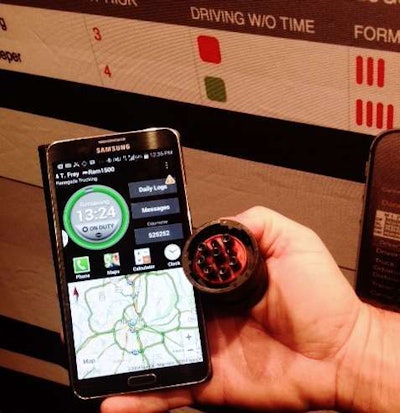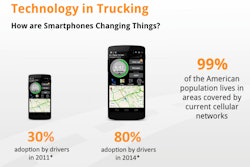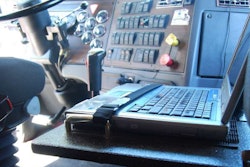
Technically, what you see above is the CFR 395.15-compliant Automatic On-Board Recording Device BigRoad promised this summer, notes BigRoad COO Terry Frey, with whom I spoke at the National Association of Small Trucking Companies’ annual conference in Nashville this past weekend. The unit is an update beyond BigRoad’s software-only logging and management apps most drivers will be familiar with today. The company worked with an Indiana-based manufacturer to produce the link to the engine’s ECM that you see in the picture above.
That small unit, which plugs into the truck’s data portal (in many, it’s on the driver’s side at various points under the dash), communicates via a Bluetooth connection with software that has a look and feel similar to BigRoad’s current applications, installed on operators’ Android- or iOS-powered smartphones or tablets.
The “DashLink” software you can think of as an upgrade to what the company currently offers, and it comes with attendant versions manageable from the back office, where such is needed. The entire package is currently operating under a rental model, at $10 a month for the plugin hardware, $15 for the software, of a piece with BigRoad’s continued goal to be the “most affordable” among ELDs/EOBRs/AOBRDs on the market. In future, Frey said, fleets that already own their own engine-connected devices that communicate via Bluetooth will be able to transition to BigRoad with custom company certification of the connection.
 BigRoad’s Terry Frey
BigRoad’s Terry FreyThe NASTC show was among the first public debuts of the solution, as Frey emphasized the company’s been focusing on keeping up with demand from the fleets and operators among current BigRoad users, with around 800 units shipped so far — “more than that” following success at the show, Frey felt confident in saying.
In an hours/e-logs-devoted session at the NASTC conference on Friday, Fleet Safety Services consultant Jeff Davis reiterated facts relevant to hours violations at roadside in today’s world. “When we look at all of the violations” in the Hours of Service category in the CSA program, he said, “70 percent of the time [the violations are] ‘form and manner’ or ‘logbook not current'” infractions. “What we’re learning from CSA is that we’re grading the secretarial skills of the truck driver. That’s what the CSA [hours category] now measures,” by and large.
Logging apps like BigRoad — another gaining traction with a large number of drivers in recent times is the KeepTruckin’ app — have thinned down the margin of “secretarial” error possible in the paper environment, offering a benefit even without a 395.15-compliant engine connection. With such a connection, Frey believes, those accustomed to running with an AOBRD will be perfectly positioned for the ELD mandate when it comes, which he believes will have a realistic compliance date in closer to four years, not the two that FMCSA hopes for and which have been noted in numerous reports.
On a related matter, Frey emphasized ongoing work the company has been doing in outreach to state enforcement departments relative to their current logging app, which FMCSA’s July clarification of guidance to law enforcement noted was an acceptable form for record-keeping purposes as well as enforcement purposes. However, Frey continued to emphasize, departments retain the option to force you to print logs and history for them. “Buy a $20-$30 printer,” he said, and think of it as “insurance against that exception. Back in September, we started telling everybody we’re working with, ‘Here are four printer options – just in case.’ Most of the time, the enforcement officer goes, ‘We’ll look at your device.’ But Missouri? No.”
The state remains a holdout by and large in most locations, Frey said. Here’s a link to BigRoad’s printer guidance.










